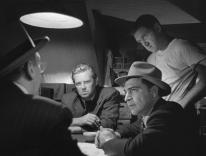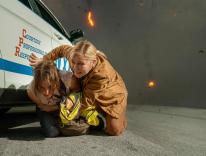C. S. Lewis (1898–1963), always multi-faceted and versatile, continues to elude definition and provoke controversy. A major polemicist and great proselytizer, Lewis was regarded by millions as a modern Christian knight. He wrote The Chronicles of Narnia, a remarkable children’s series often described as Christian allegory.
Lewis also produced seminal works of literary criticism on medieval and Renaissance subjects, enduring science fiction novels, one of the world’s great spiritual autobiographies, Surprised by Joy, and many works beyond category, most notably The Screwtape Letters. Lewis has fair claim to being one of the most important writers in English in the first half of the twentieth century—the modern era he loathed in so many ways.
Born and raised in Belfast, Ireland, by middle-class, Anglican parents, Lewis was “a visionary boy,” creating whole worlds of talking animals. Lovers of Narnia will see its origins in Animal-Land or Boxen, the fantastic, and astonishingly detailed world invented, populated, and chronicled by Lewis and his beloved older brother. Having lost his mother when he was nine, Lewis endured English public schools, survived World War I, won a scholarship to Oxford, became a don and friend of J. R. R. Tolkien, and began publishing beyond the academy when he was forty. In his forties and fifties, he was an extremely popular writer and also a renowned scholar and critic. He died the same day as President John F. Kennedy.
The Narnia series has received renewed attention with the release of the film adaptation of The Lion, the Witch, and the Wardrobe, the first volume in the series. The film is being marketed to Christian audiences, so it will be interesting to see how the filmmaker renders the book’s core spiritual pattern and significant Christian elements. For many readers, Lewis’s Christian doctrine is the heart and soul of the narrative; not to recognize the spiritual imperative is naive, or worse. To religious readers, The Chronicles of Narnia are adroit instruction, like precalculus, preparing children for the real thing.
At many junctures throughout the seven volumes of Narnia, didactic lessons are prominent. This is, from the outset, a story in which the four young protagonists—Lucy, Peter, Susan, and Edmund—are regularly addressed as “Son of Adam” or “Daughter of Eve.” Yet, I contend that despite its richly spiritual pattern and iconographic components, The Chronicles of Narnia are neither consistently allegorical nor primarily didactic. The Lion, the Witch, and the Wardrobe in particular can very well be read without persistently allegorical interpretation.
There are certainly Christian elements in Lion, which recounts the four children’s discovery of Narnia through a magic wardrobe. In the book Edmund initially disbelieves his sister Lucy’s account of that other world. When Edmund reaches Narnia he succumbs to the temptation of the White Witch and betrays his siblings. Narnia suffers under the tyranny of the Witch: it’s always winter and never Christmas. But the good creatures of Narnia have hope: Aslan the Lion, the mysteriously absent “Lord of the Wood,” is on the move. Aslan, whose very name fills the children with “that strange feeling—like the first signs of spring, like good news,” sacrifices himself to save Edmund. Bound, shaven, mocked, Aslan is killed, mourned, and miraculously restored to life, “great and terrible at the same time.” He storms the castle and revivifies innocent creatures literally petrified by the Witch. Summarized thus, it is a story of fall and redemption. Martyred and resurrected, Aslan is unmistakably a Christ-figure whose sacrifice resonates throughout the seven volumes of Narnia.
It also seems evident that Christian doctrine becomes progressively central in the series. By volume seven, The Last Battle, even the most stubborn skeptic would perceive the drama of apocalypse and redemption. The denouement of The Last Battle is “Chapter One of the Great Story, which goes on forever.” Completing this last book of The Chronicles of Narnia, Lewis makes emphatic the implicit spiritual pattern and the finality of closure: “And for us, this is the end of all the stories, and we can most truly say that they all lived, happily ever after. But for them, it was only the beginning of the real story. All their life in this world and all their adventures in Narnia had only been the cover and the title page.”
Lewis himself once said that “the whole Narnian story is about Christ.” In an essay titled “Sometimes Fairy Stories May Say Best What’s to Be Said,” Lewis characterizes his Narnian project as a stealth campaign, to “steal past watchful dragons” (he means skeptics, atheists, modernists) to depict the “real potency” of Christianity; in this formulation, the tale is told to deliver the gospel. He even provided an abstract or synopsis of the chronicles from Genesis to Apocalypse: Prince Caspian recounts the “restoration of the true religion after a corruption”; The Horse and His Boy dramatizes “the calling and conversion of the heathen”; The Magician’s Nephew depicts “the Creation and how evil entered Narnia”; etc.
In The Chronicles of Narnia, Lewis created something both like and unlike allegory: a marvelous narrative with metaphoric implications and mythic resonance. Christian doctrine is one of several resources from which Lewis draws: besides Aslan, the book’s characters include Father Christmas, Tumnus the faun, and talking beavers, characters inspired by Lewis’s vast reading of classical mythology, Norse epics, medieval bestiaries, fairy tales, more or less all Western literature from Homer through Spenser’s Faerie Queene. Vastly erudite, Lewis as narrator of the Chronicles is pedagogic but not pedantic or dogmatic. Never in Narnia are there authorial winks or nudges, underscoring the “real” or hidden meaning. Lewis’s preaching is of another order, and sometimes amusing: three times he reminds young readers that it is very foolish to shut the door behind oneself in a wardrobe!
Usually in Narnia, and certainly throughout The Lion, the Witch, and the Wardrobe, the narrative thrills without proselytizing its young readers. Kids are carried away by the excitement of being transported by a giant or a flying lion: Narnia is a land, above all, of mystery and wonder. One glorious sequence signaling the coming of Aslan, the sudden melting of winter and budding of spring, depicts an event at once amazing and familiar.
Until the resurrection of Aslan in The Lion, the Witch, and the Wardrobe, the book could have been written by E. Nesbit (Five Children and It). Children regard the return of Aslan (I can testify on behalf of my own children, Kaitlin and Amanda) as “good magic,” wonderful, but not more sacred than the strange encounters, fantastic spectacles, and mysterious events in Alice in Wonderland, Five Children and It, or The Borrowers. There is the grown-up world of dentists and broccoli and bedtime, and there, just through the wardrobe and past the streetlamp, is Narnia. It is telling that Lucy, Edmund, Peter, and Susan are not faintly religious, before or after Aslan’s miraculous return: no evening prayers, no Bible reading, no urgent prayers even in parlous straits. The Lion, the Witch, and the Wardrobe is not a systematic allegory teaching Christian doctrine.
Allegory, properly speaking, manifestly and continuously represents a separate philosophy or sequence of events, for the primary (though not exclusive) purpose of highlighting or inculcating a doctrine or system of belief. An abstract idea or conception organizes and determines the narrative. Examples in English literature include Everyman, The Faerie Queene, and Pilgrim’s Progress. In John Bunyan’s Pilgrim’s Progress, the wayfaring hero named Christian navigates Vanity Fair and the Slough of Despond and other dangers to reach Celestial City. Bunyan’s narrative, sacrificing detailed characterization, individual motivation, and verisimilitude, only makes sense as an allegorical representation of human travail through this world to the next. In 1933 Lewis wrote The Pilgrim’s Regress: An Allegorical Apology for Christianity, Reason, and Romanticism, and his first book of literary criticism was The Allegory of Love. Lewis might be said to have written the book on allegory; had he wished to make The Chronicles of Narnia an explicit allegory, he could very well have done so.
The Lion, the Witch, and the Wardrobe does not prescribe doctrine and faith. Unlike Bunyan’s allegorical types (characters named Pliable or Hopeful), the four children are differentiated, delineated by particular traits and motivations. Lewis’s various protagonists in Narnia, not just the children but the gallant mouse Reepicheep, the perpetual pessimist Puddleglum, and many more, live vitally and independently—not to illustrate something higher or deeper. The Chronicles of Narnia, like The Lord of the Rings, sustain and succor readers without being didactic. Possibilities for interpretation remain open.
The critical and interpretive possibilities are multiple and complex enough to be vigorously debated in a new volume of essays by twenty-five critics, Revisiting Narnia: Fantasy, Myth and Religion in C. S. Lewis’s Chronicles (BenBella Books). These writers, including authors of fantasy fiction, scholars from different disciplines, ministers and priests, a “liberal feminist agnostic,” and an animal-rights advocate, disagree widely—and blessedly. There is no consensus on how purposefully, pervasively, systematically, and effectively The Chronicles of Narnia “plant the seeds of Christian faith” or are a “vehicle for Lewis’s lessons of Christianity.” Whatever assumptions one brings to (or meanings one derives from) The Chronicles of Narnia are bound to be unsettled by competing arguments and contrary evidence. Narnia remains highly contested territory.
Lewis himself seems to have been of contrary minds about his intentions. The truth is that his designs, as well as their effects, are mixed and various. He wrote very quickly, neglecting inconsistencies that troubled his friend Tolkien, a more meticulous craftsman. The Chronicles of Narnia have the defects of their virtues and vice versa. In their astonishing fecundity and inventiveness, they are sometimes contradictory. The time scheme, and the relation between Narnian and Greenwich Mean Time, are incoherent if not random. More significantly, the rules of the game seem to shift. The ability and willingness of Aslan to intervene, for example, and the nature of human agency, are variable. In Prince Caspian, Lucy implores Aslan, “And I thought you’d come roaring in and frighten all the enemies away—like last time. And now everything is going to be horrid.” Aslan’s response is tender but confusing: “It is hard for you, little one. But things never happen the same way twice.” Some of the volumes are quests, more like myth or legend than theology or Scripture. In The Voyage of the Dawn Treader and The Silver Chair, the adventures of the heroes and heroines are more contingent than providential, less dependent on Aslan’s miraculous interventions. In other sagas, such as The Horse and His Boy, Aslan is ubiquitous; often in other shapes or forms, he determines much of the action and inculcates very particular lessons.
As we are reminded several times, Aslan is not a tame lion! One thing he will not do is stand still and mean one thing. Hence Aslan is a figure for—but not an allegorical representation of—Christ. To Lewis this was a distinction worth making, if not always maintaining: “The Passion and Resurrection of Aslan,” he wrote in a letter in 1960, “are the Passion and Resurrection Christ might be supposed to have had in that world—like those in our world but not exactly alike.” If at other times, as I’ve indicated, Lewis stressed his doctrinal purpose, on this distinction between allegory and metaphoric representation, Lewis was quite consistent. (Though we always have good reason to remember D. H. Lawrence’s remark, “Never trust the artist. Trust the tale.”) Writing to a fifth-grade class, Lewis stressed his broader artistic purpose: “I did not say to myself, ‘Let us represent Jesus as he really is in our world by a lion in Narnia.’ I said ‘Let us suppose that there was a land like Narnia and that the Son of God, as he became a man in our world, became a lion there, and then imagine what would happen’” (my emphasis).
If Narnia and Aslan stand for anything, it is the capacity to “suppose,” to imagine what would happen, not necessarily to affirm the everlasting grace of the Redeemer or the infinite mercy of the Lord. The story has potent energies and some unruly tendencies, independent of any system or doctrine. Like any great work of art, The Chronicles of Narnia provoke and reward multiple interpretations, competing possibilities. One possibility it encourages us to believe, if we are receptive to the power of language, is the majestic capacity of imagination to envision and dramatize. In this power one might truly have faith. Then the rewards are indeed miraculous, for “Once a King or Queen in Narnia, always a King or Queen in Narnia.”
Related: Wardrobe Malfunction, by Paul O'Donnell
Richard Alleva's review of the film The Lion, The Witch, and the Wardrobe
Please email comments to [email protected] and join the conversation on our Facebook page.
Previous Story
Abuse in Philadelphia
Next Story
Quiet, Please


